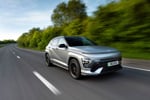Heated mirrors are just as useful – even more so if you have a solid bulkhead – in a van as in a car and electric windows are so predominant now that manual operation simply feels archaic.
Manufacturers have been switching on to this for some time – Vauxhall started the trend back in the days of the Astravan Sportiv with sports seats, metallic paint and alloy wheels.
Colour is another feature which is of primary importance to the private car buyer and which is now growing in importance for vans too. White is the traditional finish, for very good reasons, but more vans are now appearing in brighter colours which are designed to appeal specifically to the retail customer.
This has its origins in the mid-90s and Iveco's facelift Daily, in a bright, almost luminous, green. Today we have silver and steel blue Transits and these work particularly well on the Connect, due to that sector's proximity to the car market. Many people find the best of both worlds in a car-derived van and it makes sense to offer these in more popular colours for that reason.
Creature comforts and 'nice' colours are very much aimed at the retail rather than fleet markets. Given the volume discounts available to fleets, manufacturers are less inclined to include such features as standard on the vans available to them purely because they need to keep costs pared to the bone.
Different colours, however, are not automatically welcome in the van market. One national delivery company is currently changing its fleet from blue, or traditional white, to yellow.
Historically the van trade has not favoured yellow and when Fiat used it on the Ducato it earned it an unfortunately disparaging tag best not referred to in a business publication.
With the range of colours now available on vans, it is therefore wise for disposal managers to take an increased interest in the perceptions of the used market and the retail van buyer in particular. Expecting CAP Average on every vehicle at three years and 100,000 miles without understanding the market's perception of colour may lead to some surprises. It may also lead to difficult decisions and the need to really understand the impact of colour on values.
For example, if a colour is unpopular it still may not be worthwhile spending £500 to £650 repainting it into a more acceptable finish. Some large fleet operators – especially those with European operations – will need to understand the difference between their various markets.
A wider range of colours is the norm on the continent but this does not mean that those colours will succeed in the British marketplace.
The traditionally dominant position of white is certainly starting to erode in this country. Ford's steel blue Transit works well and metallic silver is increasingly becoming a standard colour.
Red, some shades of blue and even black can also work for the retail buyer, although only in very limited numbers in the case of the latter.
But it is unwise to assume that, despite the growing similarities with the car market, all car-like features will sit well on a van. Careful monitoring of disposal values for different colours will always pay off and offer a useful steer on the way to go when ordering new units.'













Login to comment
Comments
No comments have been made yet.